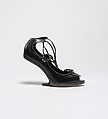"Bhutan"
Designer Manolo Blahnik British
Not on view
With this "no heel" wedge, first explored in his fall/winter 1979-80 collection and varied over the years, Blahnik conflates a number of references and locates them in the tradition of the isolated kingdom of Bhutan. The steep arch of the eccentric cantilevered sole of the shoe creates the triangulated profile of a "Lotus" shoe, those tiny platformed booties that for centuries covered the bound feet of Chinese women, but it is also a subtle homage to Roger Vivier, who, in the 1950s, shifted the heel to the center of the arch of the foot in one of his designs. For all its vertiginous instability and impracticality, the design is finished with the coarser details of a functional shoe. One imagines that in Blahnik's fictive Bhutan-like Shangri-la, far above the Himalayan cloud line, even peasant women teeter like ballerinas or Han dancers on such shoes.
"This is the kind of work I love to do because it is free from commercial constraints. With shoes like these, I don't ever think of selling. They just satisfy the creative craving that I get. They allow me to combine different times and places: in this one, for example, I mix the brutality of Etruscan fortitude with a bit of Scottish Highlands and then a touch of the extremities of Celia Cruz, the Cuban singer who I admired so much as a child! It's completely irrational, I know, but this is the work that keeps me going."
-Manolo Blahnik
Due to rights restrictions, this image cannot be enlarged, viewed at full screen, or downloaded.
This artwork is meant to be viewed from right to left. Scroll left to view more.




